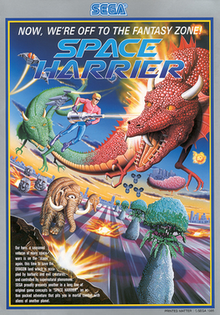| Space Harrier | |
|---|---|
 European arcade flyer | |
| Developer(s) | Sega |
| Publisher(s) | Sega |
| Designer(s) | Yu Suzuki |
| Composer(s) | Hiroshi Kawaguchi Yu Suzuki Yuzo Koshiro (X68000) Mark Cooksey (C64) |
| Platform(s) | |
| Release | October 2, 1985
|
| Genre(s) | Rail shooter |
| Mode(s) | Single-player |
| Arcade system | Space Harrier hardware[8] |
Space Harrier[a] is a third-person arcade rail shooter game developed by Sega and released in 1985. It was originally conceived as a realistic military-themed game played in the third-person perspective and featuring a player-controlled fighter jet, but technical and memory restrictions resulted in Sega developer Yu Suzuki redesigning it around a jet-propelled human character in a fantasy setting. The arcade game is controlled by an analog flight stick while the deluxe arcade cabinet is a cockpit-style linear actuator motion simulator cabinet that pitches and rolls during play, for which it is referred as a taikan (体感) or "body sensation" arcade game in Japan.
It was a commercial success in arcades, becoming one of Japan's top two highest-grossing upright/cockpit arcade games of 1986 (along with Sega's Hang-On).[9] Critically praised for its innovative graphics, gameplay and motion cabinet, Space Harrier is often ranked among Suzuki's best works. It has made several crossover appearances in other Sega titles, and inspired a number of clones and imitators, while Capcom and PlatinumGames director Hideki Kamiya cited it as an inspiration for him entering the video game industry.
Space Harrier has been ported to over twenty different home computer and gaming platforms, either by Sega or outside developers such as Dempa in Japan and Elite Systems in North America and Europe. Two home-system sequels followed in Space Harrier 3-D and Space Harrier II (both released in 1988), and the arcade spin-off Planet Harriers (2000). A polygon-based remake of the original game was released by Sega for the PlayStation 2 as part of their Sega Ages series in 2003.
- ^ "Video Game Flyers: Space Harrier, Sega (EU)". The Arcade Flyer Archive. Retrieved 11 May 2021.
- ^ "Virtual Console: Space Harrier (Arcade version)". Sega. Archived from the original on March 20, 2015. Retrieved January 6, 2015.
- ^ "Space Harrier (Registration Number PA0000282162)". United States Copyright Office. Retrieved 11 May 2021.
- ^ "Overseas Readers Column: Many Videos Unveiled But Visitors Decreased" (PDF). Game Machine. No. 270. Amusement Press, Inc. 1 November 1985. p. 26.
- ^ "Availability Update" (PDF). Computer Entertainer. April 1987. p. 14.
- ^ "セガハード大百科 MASTER SYSTEM/セガマーク3対応ソフトウェア" [Sega Hardware Encyclopedia MASTER SYSTEM/Sega Mark 3 software]. Sega (in Japanese). Archived from the original on October 11, 2016. Retrieved October 4, 2016.
- ^ "Two Mega Cartridges" (PDF). The Sega Master System Game Catalog (1987). Mastertronic. Retrieved 24 September 2024.
- ^ "Sega Space Harrier Hardware". System16.com. Archived from the original on January 3, 2017. Retrieved August 5, 2006.
- ^ "Game Machine's Best Hit Games 25: '87" (PDF). Game Machine (in Japanese). No. 324. Amusement Press, Inc. 15 January 1988. p. 20.
Cite error: There are <ref group=lower-alpha> tags or {{efn}} templates on this page, but the references will not show without a {{reflist|group=lower-alpha}} template or {{notelist}} template (see the help page).